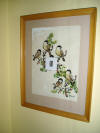Estimating past radon
and radon-related dose from radioactivity in glass:
the
Retrospective (RETRO) technique
Since radon concentrations fluctuate, sometimes wildly over days and weeks, a measurement that only captures the radon concentration over a few days time is not very reliable in estimating a person's long-term risk from radon related exposure. Techniques that can measure the radon concentrations over long periods of time give the best estimate of your long-term radon risk. A new technique, called RETRO, can reconstruct the average radon concentration for periods as long as several decades. Past radon concentrations can be useful to estimate the radon exposure that you have already received in your home or to estimate the your future radon exposure if your home is not altered. These past radon and radon progeny concentrations can be reconstructed from the indelible record that radon leaves in glass.
The technique requires a glass surface whose age is known, that is at least 5 years old, and that has spent most of its existence being exposed in a your home. Suitable glass can be as old as the memory of the owner.
The technique uses alpha particle detectors to measure the
deposited and implanted surface radioactivity.
We offer retrospective radon devices and services. Please check back for details or e-mail me to express your interest.
Here are some references for the scientific basis
and performance of the technique and the RRD detectors:
� Steck DJ, Alavanja MCR, Field RW, Parkhurst MA, Bates
DJ, Mahaffey JA. 210Po implanted in glass surfaces by long term exposure to
indoor radon. Health Phys 83:261-272; 2002.
� R.W. Field, D.J. Steck,
M.A. Parkhurst, J.A. Mahaffey, and M.C.R. Alvanja. "Comparison of
retrospective radon detectors". (Environmental Health Perspectives
107(11),901-904; 1999
� D.J. Steck and R.W. Field. �The use
of track registration detectors to reconstruct contemporary and historical
airborne radon ( 222Rn) and radon progeny concentrations for a
radon-lung cancer study� Radiation Measurements 31(1-6),401-406;1999
� R.S. Lively and D.J.
Steck; �Long-term radon concentrations estimated from 210Po embedded
in glass� Health Physics 64 (5): 485-490 (1993).
RADON RELATED DOSE RECONSTRUCTION

Questions/Comments, e-mail: Dr. Steck
Last revised : 10 October, 2007
Visitor
since 10/10/07
Disclaimer
The views and opinions expressed on the web sites hosted on this server are
strictly those of the author.
The contents of the web sites on this server have
not been reviewed or approved by the College of St.
Benedict|St. John's University.



